VO2A Brings NA-194 and 205 on the Air
by Cezar Trifu, VE3LYC
For quite some time I wanted to be for once at the other end of the pile-up, not only for the thrill and experience, but also as my own contribution to the hobby, for the many wonderful and unforgettable moments I enjoyed over the years. However, when someone has over 900 IOTAs confirmed, the one he will put on the air will obviously be rare and therefore not an easy task.
Early this year Ken (G3OCA) and I decided to head out to the Central and Northern Labrador IOTA groups NA-194 and 205. First, these groups had only been activated once, 14 and 13 years earlier, and were sitting on the Most Wanted IOTA List. Second, I always wished to visit Labrador one day and experience on my own some of its rugged landscape and austere beauty. Third, this location was close enough to largely populated areas in Europe and North America, allowing good radio traffic even at the very bottom of solar cycle.
Our base had to be in Nain, the northernmost community in Labrador. With the help of Fran and Brian Williams who reside there I got in touch with Paul Fenton, a professional guide with Labrador Wild North Expeditions (LWNE). From the beginning Paul appeared both enthusiastic and very determined. Central and Northern Labrador islands raise various logistical problems due to the potential presence of wildlife, primarily polar and black bears. Following a careful evaluation, we decided that Finger Hill Is. and Paul Is., checked and pre-approved by the IOTA Manager, would be our destinations for NA-194 and 205, respectively. They will also be all-time new ones for the Canadian Island Award (NF-73 and 74).
We travelled to Nain very lightly, carrying only Ken’s TS50 and my IC-7000 with two vertical wire antennae, sleeping bags, limited clothing and toiletry. At Paul’s request, no aerosol-based insect repellant was packed to avoid affecting the smell of Snook and Eiger, the two dogs he would bring along in this trip. Since Finger Hill Is. is situated at 160 km N-NE of Nain, we decided to reach it from Nain by helicopter rather than using a large vessel, because of its reliable availability and fast deployment, avoiding thus long navigation and potential hazardous landing on its rocky shores. Travel to Paul Is. was far less demanding, since the island lied just a few kilometers from Nain.
Ken and I met in Halifax on July 28 and next morning flew to Goose Bay where we anguished for five long days waiting a lift to Nain. Despite the generally nice weather in Goose Bay, low ceiling along the northern coast led to all flights up north being cancelled day after day. Finally, at noon on August 4 we boarded a twin Otter that was scheduled to take us to Nain after making short stops at no less than five settlements on the way. Nain is home to about 1,200 people and part of Nunatsiavut, the Inuit territory of Labrador. We arrived around 3 pm and were welcomed by Paul, who told us that we will fly out to Finger Hill Is. in a couple of hours. After lingering for almost an entire week, we were moving fast in high gear!

With everything well packed and the three-man and two-dog team squeezed in the cabin, Gary – the helicopter pilot – lifted his flying machine and directed it towards our target. As we advanced further and further north, the trees vanished fast while the islands rose to greater and greater heights above the ocean waters. Once we arrived over the crested shores of the rocky Finger Hill Is., Paul asked Gary to do a fly by over the landing side to check on the wildlife. Minutes later Gary landed softly as we were watching like visitors from another world the austere landscape with the nearby vertical massive volcanic cliffs.
Paul began setting up the tents and anti-bear fence while Ken and I started to work on raising the antennae and getting the rigs ready. We had two operation tents 30-40 m apart with Paul’s tent in between. Unfortunately, the tests showed that the TS-50 was affected by radio interference and we will not be able to operate two stations simultaneously as initially planned. We decided that I would operate 30 m CW while Ken will rest and be ready for 20 m SSB in the morning.
With only one station on the air, the pressure mounted. It only took a few calls to be faced with a large pile-up, which continued all night long. The most rewarding moment on 30 m was when the VK and ZL stations came in around the very short expected time window. In early morning I switched to 20 m CW to give the stations from JA and far-east Asia a chance. A few EU operators ignored at first my directional calls, but after the JAs picked up they cooperated and QRXed.

Once the propagation with far-east Asia winded down, Ken was ready to take over, running a pretty heavy EU and NA pile-up on 20 m SSB. Paul, who spent all night patrolling the camp to guard against any eventual wildlife intruders, was crushed and headed to rest for a few hours. Ken and I switched over from time to time to maintain a steady QSO rate and continued on 20 m SSB and CW throughout the day. Once the evening dropped I was back on 30 m CW. Unlike the night before, at some point the bands simply vanished. It wasn’t the rig, battery or antenna, but the … northern lights, putting the entire sky above us on fire! The aurora didn’t last long but killed the bands and thus gave me the chance to take a three-hour nap before waking up to catch the early morning propagation on 20 m.
 VO2A tent on Paul Is at sunset
VO2A tent on Paul Is at sunsetNext day was our last on Finger Hill Is. The weather changed suddenly with heavy grey clouds pilling up. Mosquitoes were completely merciless. The helicopter was called in and we began taking everything down. Despite relatively lower ceiling on the way back, the scenery was breathtaking. Landing in Nain was very smooth, but once outside of the helicopter we realized how cold and windy it was, probably only a few degrees above the freezing point with the windshield effect.
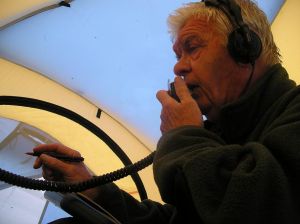 Ken has the first QSO from Paul Is on 20m SSB
Ken has the first QSO from Paul Is on 20m SSBThanks to our hosts Fran and Brian Williams, we were able to take a quick shower, re-book our flights, serve dinner and have a good night sleep. We woke up refreshed and ready for more action. Paul came to pick us up in late morning and drove us to the docks where Henry – our boatman – was waiting for us with his motor canoe. It took us less than half an hour to reach the landing site on Paul Is., north of Nain, on the other site of the bay. Minutes later the rain started and it continued well into the night, pretty heavy at times.
We were quite worried that Ken’s return to England could be seriously hampered if the weather changed abruptly and thus decided to not take any chances. The plan was to have Ken off Paul Is. the next morning in hope that he can catch a flight out of Nain right away. Thus, we decided to have only one operation tent, located about 20 m from the rocky shore.
Once this tent and the antenna were up, we were ready to go and Ken launched the first CQ on 20 m SSB. After a short contact, he noticed that his rig’s power dropped to 5 W and we both question whether the battery was well charged, replacing it in the end. With new battery in he made another QSO after which his TS-50 went silent. It was fast obvious that there was nothing we could do to revive it, and so had it replaced with my IC-7000. Ken got used right away with the foot paddle that my friend George Kennedy (VE3GHK) built for me to free hands for writing and tuning, and began working the pile-up.
We took turns at the microphone and the log increased steadily. At night fall I moved to 30 m CW and later to 40 m CW, where I logged a couple of ZL stations. After a good run the bands went silent and following many unanswered CQs I decided to take a rest. Early morning would bring the first VK station logged on 20 m CW, followed by the usual series of JA and far-east Asian stations. EU stations cooperated promptly, thus preventing the loss of time.
Ken’s departure was emotional for me. We had been through so many ups and downs together and I felt that he hated leaving me out there, but it was the responsible thing to do and we both knew it. We stood together for a photo then he jumped in the boat and was driven away by Chris, Henry’s son. Not long after that I could hear the twin Otter flying in and out of Nain.
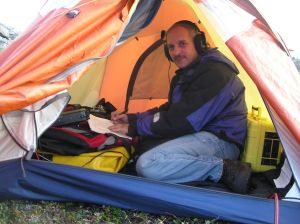 Cezar working JA/AS stations on 20m CW
Cezar working JA/AS stations on 20m CWDuring the second day of operation the wind increased steadily, bending seriously the telescopic fiberglass mast. Our wire vertical antennae had no traps and for each band change the antenna had to be brought down. One person could generally do this operation, but with a very slippery mast under rainy conditions, Paul’s assistance was necessary to avoid dropping the fiberglass and eventually shattering it by hitting hard the large rocks around.
Chris was the boatman who came to pick Paul and me up and take us to Nain. Unlike during our stay on Finger Hill Is., mosquitoes were not the worst nuisances here but the black flies. In the morning of the third day I woke up with an inflated cheek just below the left eye, which in less than one hour increased to the point of partly covering my view. Back on the mainland Fran and Brian convinced me that this reaction would subside in a few days. Next morning, however, a similar bump occurred below the right eye too as a result of more black fly bites!
My flight out of Nain wasn’t followed by a straight connection to Halifax. Instead, I had to overnight again in Goose Bay. To my surprise, I couldn’t find that night any hotel or bed and breakfast accommodation. This is when Rick (VO2KDS), who knew of our passing through Goose Bay from Brian’s blog and offered his help if in need, came to my rescue. My gratitude to Carl Sonnichsen (VO2KDS) and his wife Laura (VO2YFA) for sharing with me a very enjoyable evening, chatting about VO2A and ham radio in general, and hosting me that night.
Our logs show that from each island we made about 1700 QSOs with stations in six continents, logging 2200 different stations from 63 DXCCs. Two thirds of these contacts were in CW. The QSO distribution by continent was EU 59%, NA 34% and AS 6% from NA-194 and EU 41%, NA 51% and AS 6% from NA-205, while other continents shared the remaining percentage.
We would like to acknowledge the financial support received from IREF, GDXF, ICOM Canada, Chiltern DX Club, GM DX Club, Mediterranean DX Club and Clipperton DX Club, for which we are truly grateful. We also wish to express our appreciation to Paul Fenton and LWNE for their services and contribution towards the success of this expedition.
We would like to thank our top individual donors: JE1DXC, VE3JV, VE7QCR, JF4VXT, JA8MS, and JA1QXY. Also, we are grateful to the following stations for their generous support: EA8AKN, G3RTE, G3SWH, G4AYO, G4VMX, G4VXT, M0ADG, HE9JAT, I4MKN, IK8CNT, 7K3EOP, JA1EY, JA1BPA, JA1SKE, JA1MCU, JM1PXG, JA9IFF, W3AWU, WA3HIC, KB5GL, N5UR, N6JV, N6PYN, WA6GFE, W7AUM, K9AJ, VE3LDT, VE3UW, VE3ZZ, VE7SMP, VE9MY and VE9GLF. Finally, we would like to acknowledge the donations received from CT1BXX, DJ3XG, DJ5AI, G3DQS, G3OAG, G4PTJ, GJ3LFJ, I4EAT, I4GAD, IK4WMA, IT9DAA, IT9YRE, JQ2VVH, JA5IU, JA7DOT, JH8JYV, LA2PA, ON4IZ, ON4XL, PT7WA, S55SL, SM6CVX, W1-7897, AA1ON, KH2AR, WB2YQH, KC3RT, N4AH, W4ABW, W4MOT, W4PGC, W5GAI, KB5RHD, W5RQ, W5ZPA, AB6QM, W6RLL, N6VS, N7RO, K8CW, K9RR, K9YNF and VE1WT.




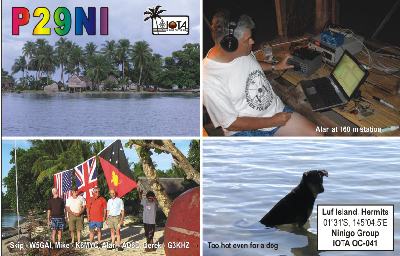

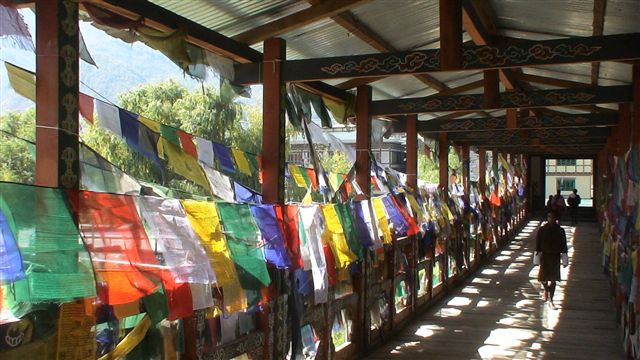
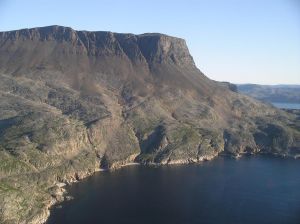







 on the toolbar to send me your comments.
on the toolbar to send me your comments.




